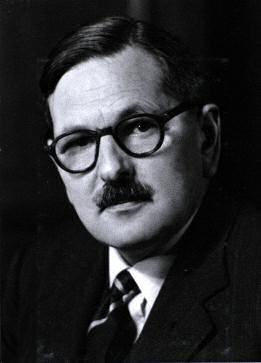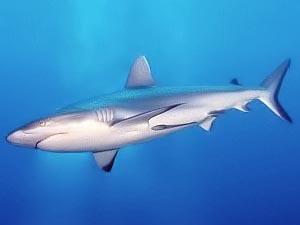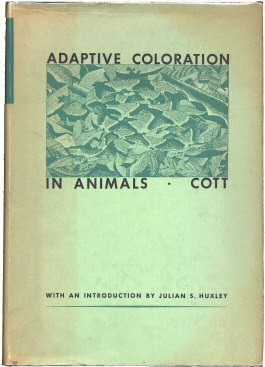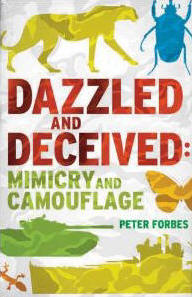
Camouflage is the use of any combination of materials, coloration, or illumination for concealment, either by making animals or objects hard to see, or by disguising them as something else. Examples include the leopard's spotted coat, the battledress of a modern soldier, and the leaf-mimic katydid's wings. A third approach, motion dazzle, confuses the observer with a conspicuous pattern, making the object visible but momentarily harder to locate, as well as making general aiming easier. The majority of camouflage methods aim for crypsis, often through a general resemblance to the background, high contrast disruptive coloration, eliminating shadow, and countershading. In the open ocean, where there is no background, the principal methods of camouflage are transparency, silvering, and countershading, while the ability to produce light is among other things used for counter-illumination on the undersides of cephalopods such as squid. Some animals, such as chameleons and octopuses, are capable of actively changing their skin pattern and colours, whether for camouflage or for signalling. It is possible that some plants use camouflage to evade being eaten by herbivores.

Yakumo Koizumi , born Patrick Lafcadio Hearn, was an Irish-Greek writer, translator, and teacher who introduced the culture and literature of Japan to the West. His writings offered unprecedented insight into Japanese culture, especially his collections of legends and ghost stories, such as Kwaidan: Stories and Studies of Strange Things. Before moving to Japan and becoming a Japanese citizen, he worked as a journalist in the United States, primarily in Cincinnati and New Orleans. His writings about New Orleans, based on his decade-long stay there, are also well-known.

The Boomtown Rats are an Irish new wave band originally formed in Dublin in 1975. Between 1977 and 1985, they had a series of Irish and UK hits including "Like Clockwork", "Rat Trap", "I Don't Like Mondays" and "Banana Republic". The original line-up comprised six musicians; five from Dún Laoghaire in County Dublin; Gerry Cott, Simon Crowe (drums), Johnnie Fingers (keyboards), Bob Geldof (vocals) and Garry Roberts, plus Fingers' cousin Pete Briquette (bass). The Boomtown Rats broke up in 1986, but reformed in 2013, without Fingers or Cott. Garry Roberts died in 2022. The band's fame and notability have been overshadowed by the charity work of frontman Bob Geldof, a former journalist with the New Musical Express.

Primo Water Corporation is an American-Canadian water company offering multi-gallon bottled water, water dispensers, self-service refill water machines, and water filtration appliances. The company is headquartered in Tampa, Florida, and services residential and commercial customers across the United States, Canada, Europe, and Israel.

Neal James Cotts is an American former professional baseball pitcher. He played in Major League Baseball (MLB) for the Chicago White Sox, Chicago Cubs, Texas Rangers, Milwaukee Brewers, and Minnesota Twins.

William Whitaker Taylor was a member of the Utah Territorial Legislature, member of the Presidency of the Seventy in the Church of Jesus Christ of Latter-day Saints, and a son of LDS Church president John Taylor. He was a half brother to John W. Taylor, a member of the Quorum of the Twelve Apostles who was dropped from the body and excommunicated for refusing to give up plural marriage, and a brother-in-law to George Q. Cannon.

John Van Cott was a prominent member of the Church of Jesus Christ of Latter-day Saints serving as a member of the Quorum of the Seventy, as one of the Seven Presidents of the Seventy, and also as president of the Scandinavian Mission.

Hugh Bamford Cott was a British zoologist, an authority on both natural and military camouflage, and a scientific illustrator and photographer. Many of his field studies took place in Africa, where he was especially interested in the Nile crocodile, the evolution of pattern and colour in animals. During the Second World War, Cott worked as a camouflage expert for the British Army and helped to influence War Office policy on camouflage. His book Adaptive Coloration in Animals (1940), popular among serving soldiers, was the major textbook on camouflage in zoology of the twentieth century. After the war, he became a Fellow of Selwyn College, Cambridge. As a Fellow of the Zoological Society of London, he undertook expeditions to Africa and the Amazon to collect specimens, mainly reptiles and amphibians.

Countershading, or Thayer's law, is a method of camouflage in which an animal's coloration is darker on the top or upper side and lighter on the underside of the body. This pattern is found in many species of mammals, reptiles, birds, fish, and insects, both in predators and in prey.

Animal colouration is the general appearance of an animal resulting from the reflection or emission of light from its surfaces. Some animals are brightly coloured, while others are hard to see. In some species, such as the peafowl, the male has strong patterns, conspicuous colours and is iridescent, while the female is far less visible.
Dorothy Louise Eady, also known as Omm Sety or Om Seti, was a British antiques caretaker and folklorist. She was keeper of the Abydos Temple of Seti I and draughtswoman for the Department of Egyptian Antiquities. She is known for her belief that in a previous life she had been a priestess in ancient Egypt, as well as her considerable historical research at Abydos. Her life and work has been the subject of many articles, television documentaries, and biographies.
Cotts is a surname. Notable people with the surname include:

Adaptive Coloration in Animals is a 500-page textbook about camouflage, warning coloration and mimicry by the Cambridge zoologist Hugh Cott, first published during the Second World War in 1940; the book sold widely and made him famous.

Corey Michael Cott is an American actor and singer. He is best known for playing Jack Kelly in the Broadway musical Newsies, replacing Jeremy Jordan, and for originating the role of Donny Novitski in the Broadway musical Bandstand.

Casey Morton Cott is an American actor, known for his role as Kevin Keller on The CW series Riverdale.

Dazzled and Deceived: Mimicry and Camouflage is a 2009 book on camouflage and mimicry, in nature and military usage, by the science writer and journalist Peter Forbes. It covers the history of these topics from the 19th century onwards, describing the discoveries of Henry Walter Bates, Alfred Russel Wallace and Fritz Müller, especially their studies of butterflies in the Amazon. The narrative also covers 20th-century military camouflage, begun by the painter Abbot Thayer who advocated disruptive coloration and countershading and continued in the First World War by the zoologist John Graham Kerr and the marine artist Norman Wilkinson, who developed dazzle camouflage. In the Second World War, the leading expert was Hugh Cott, who advised the British army on camouflage in the Western Desert.
Cott is a surname. Notable people with this surname include:













